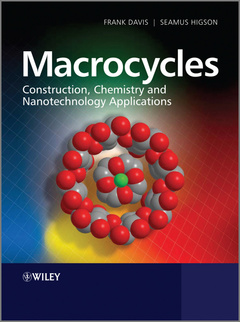Description
Macrocycles
Construction, Chemistry and Nanotechnology Applications
Authors: Davis Frank, Higson Séamus
Language: English
Subject for Macrocycles:
Keywords
molecules; macrocyclic; contain; precise; nanotechnology; goal; important; blocks; synthesizing; structures; example; vessel; reaction; switches; computers; components; potential; molecular; catalysts; applications; essential
Publication date: 04-2011
608 p. · 18.9x24.7 cm · Paperback
Publication date: 04-2011
608 p. · 19.8x25 cm · Hardback
Description
/li>Contents
/li>Biography
/li>
Macrocycles: Construction, Chemistry andNanotechnologyApplications is an essential introduction this important class of molecules and describes how to synthesise them, their chemistry, how they can be used as nanotechnology building blocks, and their applications. A wide range of structures synthesised over the past few decades are covered, from the simpler cyclophanes and multi-ring aromatic structures to vases, bowls, cages and more complex multi-ring systems and 3D architectures such as ?pumpkins?, interlocking chains and knots. Topics covered include:
- principles of macrocycle synthesis
- simple ring compounds
- multi-ring aromatic structures
- porphyrins and phthalocanines
- cyclophanes
- crown ethers, cryptands and spherands
- calixarenes, resorcinarenes, cavitands, carcerands, and heterocalixarenes
- cyclodextrins
- cucurbiturils
- cyclotriveratylenes
- rotaxanes
- catenanes
- complex 3D architectures, including trefoils and knots
Macrocycles: Construction, Chemistry andNanotechnologyApplications distills the essence of this important topic for undergraduate and postgraduate students, and for researchers in other fields interested in getting a general insight into this increasingly important class of molecules.
1. Introduction.
1.1. Simple ring compounds.
1.2. Three dimensional aliphatic carbon structures.
1.3. Annulenes.
1.4. Multi-ring aromatic structures.
1.5. Porpyrins and phthalocanines.
1.6. Conclusions.
References.
2. Cyclophanes.
2.1. Introduction to cyclophanes.
2.2. Cyclophanes with one aromatic system and aliphatic chain.
2.3. Cyclophanes with more than 1 aromatic ring.
2.4. Napthalenophanes and other aromatic systems.
2.5. Cyclophanes containing heteroaromatic systems.
2.6. Ferrocenophanes.
References.
3. Crown ethers, cryptands and other compounds.
3.1. Introduction.
3.2. Crown ethers.
3.3. Simple complexes with crown ethers.
3.4. Azacrowns, cyclens and cyclams.
3.5. Crowns containing other heteroatoms.
3.6. Lariat and bibracchial crown ethers.
3.7. Cryptands.
3.8. Spherands.
3.9. Combined and multiple systems.
3.10. Applications of crown ethers and related compounds.
3.11. Conclusions.
References.
4. Calixarenes.
4.1. Introduction to calixarenes.
4.2. History of the calixarenes.
4.3. Structures of calixarenes.
4.4. Chemical modification of calixarenes.
4.5. Complexes with calixarenes.
4.6. Bis- and multicalixarenes.
4.7. Oxacalixarenes, azacalixarenes and thiacalixarenes.
4.8. Resorcinarenes - synthesis and structure.
4.9. Cavitands and carcerands.
4.10. Uses of calixarenes and conclusions.
References.
5. Heterocalixarenes and calixnaphthalenes.
5.1. Introduction to heterocalixarenes and calixnaphthalenes.
5.2. Calixnaphthalenes.
5.3. Tropolone based macrocycles.
5.4. Calixfurans.
5.5. Calixpyrroles.
5.6. Calixindoles, calixpyridines and calixthiophenes.
5.7. Conclusions.
References.
6. Cyclodextrins.
6.1. Introduction to cyclodextrins.
6.2. Complex formation by cyclodextrins.
6.3. Cyclodextrins of other sizes.
6.4. Modification reactions of cyclodextrins.
6.5. Selectivity of cyclodextrins.
6.6. Multiple cyclodextrin systems.
6.7. Polymeric cyclodextrins.
6.8. Cyclodextrins combined with other macrocyclic systems.
6.9. Therapeutic uses of cyclodextrins.
6.10. Other uses of cyclodextrins.
6.11. Conclusions.
References.
7. Cyclotriveratylenes and cryptophanes.
7.1. Introduction to cyclotriveratrylenes and cryptophanes.
7.2. Synthesis of cyclotriveratrylenes.
7.3. Modification of cyclotriveratrylenes.
7.4. Synthesis of optically active cyclotriveratrylenes.
7.5. Modification of the bridging groups.
7.6. Modification of the aromatic rings with organometallic groups.
7.7. Selective binding applications of cyclotriveratrylenes.
7.8. Analogues of CTV.
7.9. Cryptophanes - synthesis and structure.
7.10. Cryptophanes - chemical modification.
7.11. Complexes with cryptophanes.
7.12. Cryptophane/Xenon complexes.
7.13. Other uses of cryptophanes.
7.14. Hemicryptophanes.
7.15. Conclusions.
References.
8. Cucurbiturils.
8.1. Introduction to cucurbiturils.
8.2. Complexation behaviour of simple cucurbiturils.
8.3. Modification of cucurbiturils.
8.4. Uses of cucurbiturils.
8.5. Hemicucurbiturils.
8.6. Conclusions.
References.
9. Rotaxanes and catenanes.
9.1. Introduction to rotaxanes and catenanes.
9.2. Rotaxanes.
9.3. Rotaxanes as molecular machines.
9.4. Thin films of rotaxanes.
9.5. Polyrotaxanes.
9.6. Catenanes.
9.7. Switchable catenanes.
9.8. Catenanes on surfaces.
9.9. Polycatenanes and catenated polymers.
9.10. Natural catenanes.
9.11. Conclusions.
References.
10. Other supermolecular systems, molecular motors, machines and nanotechnological applications.
10.1. Introduction.
10.2. Other molecular systems.
10.3. Molecular devices, motors and machines.
10.4. Conclusions.
References.
Cranfield University, UK
Dr Davis is a research fellow at Cranfield University, specialising in the biochemical and supramolecular aspects of electrochemistry. As well as pursuing academic research he has undertaken contract research for organisations such as Unilever Research (Port Sunlight), ITM Power Ltd (Sheffield), Timestrip (Hitchen) and DEFRA, and spent a 4-year research post within Gillette UK
Professor Séamus Higson
Cranfield University, UK
Séamus Higson is Professor of Bio- and Electro-Analysis at Cranfield University which he joined in August 2002. His previous career spans academic departments of chemistry, medicine and materials science and this is reflected in his research. Professor Higson also serves within an advisory and / or consultative capacity for a number of public bodies and also acts as Technical Director for Microarray Ltd - a company formed upon science and patents originating from his group. His current research is primarily focussed towards practical implementation of electro analytical science and analytical biochemistry for biomedical, environmental and industrial process control applications.




